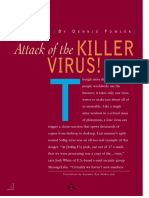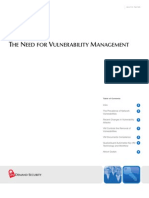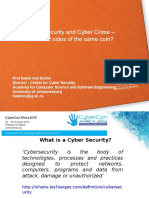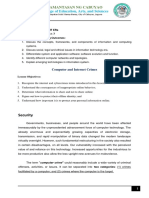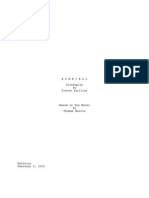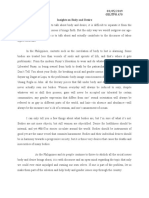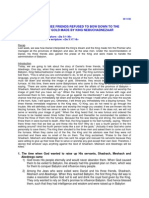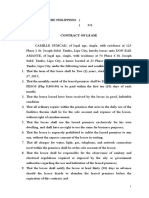0 ratings0% found this document useful (0 votes)
76 views1.current Cyber Threat
1.current Cyber Threat
Uploaded by
Adil Raza SiddiquiThis document discusses trends in computer security such as cyberwar, consumerization of IT, and advanced persistent threats (APT). It notes that while security specialists have long been in an arms race with cyber criminals, criminals now have the upper hand. The goal of the course is to understand why we are losing this war. It also discusses the evolution of threats from unknown viruses in the 1990s to today's profit-driven cyber crimes and evolution of attacks rather than revolution. Most security solutions only protect from a fraction of threats.
Copyright:
© All Rights Reserved
Available Formats
Download as PDF, TXT or read online from Scribd
1.current Cyber Threat
1.current Cyber Threat
Uploaded by
Adil Raza Siddiqui0 ratings0% found this document useful (0 votes)
76 views18 pagesThis document discusses trends in computer security such as cyberwar, consumerization of IT, and advanced persistent threats (APT). It notes that while security specialists have long been in an arms race with cyber criminals, criminals now have the upper hand. The goal of the course is to understand why we are losing this war. It also discusses the evolution of threats from unknown viruses in the 1990s to today's profit-driven cyber crimes and evolution of attacks rather than revolution. Most security solutions only protect from a fraction of threats.
Original Description:
Current Cyber threats in modern technology
Original Title
1.Current Cyber Threat
Copyright
© © All Rights Reserved
Available Formats
PDF, TXT or read online from Scribd
Share this document
Did you find this document useful?
Is this content inappropriate?
This document discusses trends in computer security such as cyberwar, consumerization of IT, and advanced persistent threats (APT). It notes that while security specialists have long been in an arms race with cyber criminals, criminals now have the upper hand. The goal of the course is to understand why we are losing this war. It also discusses the evolution of threats from unknown viruses in the 1990s to today's profit-driven cyber crimes and evolution of attacks rather than revolution. Most security solutions only protect from a fraction of threats.
Copyright:
© All Rights Reserved
Available Formats
Download as PDF, TXT or read online from Scribd
Download as pdf or txt
0 ratings0% found this document useful (0 votes)
76 views18 pages1.current Cyber Threat
1.current Cyber Threat
Uploaded by
Adil Raza SiddiquiThis document discusses trends in computer security such as cyberwar, consumerization of IT, and advanced persistent threats (APT). It notes that while security specialists have long been in an arms race with cyber criminals, criminals now have the upper hand. The goal of the course is to understand why we are losing this war. It also discusses the evolution of threats from unknown viruses in the 1990s to today's profit-driven cyber crimes and evolution of attacks rather than revolution. Most security solutions only protect from a fraction of threats.
Copyright:
© All Rights Reserved
Available Formats
Download as PDF, TXT or read online from Scribd
Download as pdf or txt
You are on page 1of 18
At a glance
Powered by AI
Some key takeaways are that computer security is an ongoing arms race between experts and criminals, with criminals currently having the upper hand. Sticking to security rules may not provide immediate benefits while bypassing rules is often easy. Consumerization of IT has also reshaped computer security.
Some popular myths about computer security include that following security best practices guarantees protection and that lack of media coverage means systems have become more secure. In reality, computer security is an evolving challenge and most solutions only protect from a fraction of threats.
Organised crime taking interest in computer systems has changed the landscape by making attackers increasingly profit-driven rather than fame-seeking. This has professionalized cyber attacks and increased their frequency and sophistication.
Cyberwar, consumerisation
of IT and APT, or new trends
in computer security
It follows its own rules
Sticking to the rules doesnt bring immediate benefits and may turn into a tedious
routine, while bypassing or even flouting rules is often easy and not considered risky
Computer experts have a vastly wider knowledge and interest in security than the
average user
For the longest time, theres been an arms race between security specialists and cyber
criminals
The criminals have the upper hand now
The goal of this course is to understand why we are losing this war
The world of computer system connected to the Internet
may prove dangerous for users if you downplay its perils:
Even if each user is only attacked once a
month, statistically 20 million attacks
monthly reach their targets and compromise
the systems, meaning 240 million machines
become infected yearly
The 1990s: Fear of the Unknown
The 1990s: Fear of the Unknown
There's a new virus on the loose that's worse than
anything I've seen before! It gets in through the power
line, riding on the powerline 60 Hz subcarrier. It works by
changing the serial port pinouts, and by reversing the
direction one's disks spin. Over 300,000 systems have
been hit by it here in Murphy, West Dakota, alone! And
that's just in the last 12 minutes.
Read messages. No,
not even this one!
Use serial ports,
modems, or phone
lines.
Use batteries either.
Upload or delete or
download files.
Use the powerline.
(there are rumours that
this virus has invaded
most major battery
plants, and is infecting
the positive poles of
the batteries.)
Use keyboards,
screens, or printers.
Use electric lights,
electric or gas heat,
or airconditioning,
running, water, fire,
clothing, or the
wheel.
The world of computer system connected to the Internet
may prove dangerous for users if you downplay its perils:
Exploited an IIS server vulnerability to deface affected websites
Infections doubled every 27 minutes
Every 20 or 27 days, it run denial of service attacks
against selected web servers
Propagated in 12 different ways
Infected more than 2 million computers in three days
Spread over the entire web in just 2.5 hours
The Cyber Crime Era
Fame-seeking is no longer a motivator for attackers. They are now profit-driven
The lack of mass media coverage on viruses doesnt mean computer systems have
become more secure lately: quite the opposite
The Cyber Crime Era
G
Its an Evolution, not Revolution
Its an Evolution, not Revolution
Its an Evolution, not Revolution
Most security solutions only protect you from a fraction of threats
What popular
beliefs about
computer systems
security are in fact
just myths?
Does organised
crime taking an
interest in
computer systems
security change its
landscape?
What is a
cyberwar?
How has the
consumerisation of
IT reshaped our
security?
What types of
attacks threaten
every computer
system?
What is the
ultimate objective
of the attacks?
18
You might also like
- PCIP Practice QuestionsDocument30 pagesPCIP Practice QuestionsAdil Raza Siddiqui93% (30)
- Cyber Security Seminar ReportDocument19 pagesCyber Security Seminar ReportManik Sharma77% (26)
- Handbook of Language and Ethnic Identity (Joshua A. Fishman) (Z-Library)Document481 pagesHandbook of Language and Ethnic Identity (Joshua A. Fishman) (Z-Library)Pranav KarunNo ratings yet
- George MacKenzie - The Story of Each Playing CardDocument20 pagesGeorge MacKenzie - The Story of Each Playing CardMatthew WrightNo ratings yet
- Cyber SecurityDocument13 pagesCyber SecurityVinay BharwaniNo ratings yet
- (Group 9) Technology Presentation HandoutsDocument2 pages(Group 9) Technology Presentation HandoutsMai LinhNo ratings yet
- Computer VirusDocument11 pagesComputer VirusThe Heartfelt CreationNo ratings yet
- Paper: Computer Security in The Real World: 6.826-Principles of Computer Systems 2004Document14 pagesPaper: Computer Security in The Real World: 6.826-Principles of Computer Systems 2004exlibrizNo ratings yet
- Attack of The Killer Virus!Document7 pagesAttack of The Killer Virus!John GacheruNo ratings yet
- Social Engineering in The Internet of Everything: Cutter IT Journal July 2016Document11 pagesSocial Engineering in The Internet of Everything: Cutter IT Journal July 2016jorgeNo ratings yet
- What Is Cybersecurity and Why It Is ImportantDocument22 pagesWhat Is Cybersecurity and Why It Is ImportantOgieva ElvisNo ratings yet
- DocumentDocument16 pagesDocumentVaibhav BhardwajNo ratings yet
- Need For Vuln Management 1Document9 pagesNeed For Vuln Management 1ladyjay3710No ratings yet
- 73Document4 pages73Sahira SangiNo ratings yet
- Guide To Computer Network Security Chapter3Document23 pagesGuide To Computer Network Security Chapter3SonjaNo ratings yet
- SR24306174323Document4 pagesSR24306174323Lamia BouaitaNo ratings yet
- Network SecurityDocument161 pagesNetwork Securityjollyjingles93No ratings yet
- Cyber Security Challenges With Latest TechnologiesDocument6 pagesCyber Security Challenges With Latest TechnologiesIJRASETPublicationsNo ratings yet
- Security Considerations in e BankingDocument29 pagesSecurity Considerations in e Bankingsakshivam100% (1)
- Eaton Cyber Security Infographic FINALDocument1 pageEaton Cyber Security Infographic FINALljlkNo ratings yet
- Chapter 7 SIMTEKDocument12 pagesChapter 7 SIMTEKnafisahNo ratings yet
- AcknowledgementsDocument37 pagesAcknowledgementsbanerjeearindam888No ratings yet
- “Computer Viruses Unveiled: Types, Trends and Mitigation Strategies”: GoodMan, #1From Everand“Computer Viruses Unveiled: Types, Trends and Mitigation Strategies”: GoodMan, #1No ratings yet
- Network Security: It Is A Process, Not A Product Jaymark B. MarcosDocument2 pagesNetwork Security: It Is A Process, Not A Product Jaymark B. MarcosJayMark BautistaNo ratings yet
- The Changing Threat: PlenaDocument52 pagesThe Changing Threat: Plenajo1327No ratings yet
- A Study of Cyber Security Challenges and Its EmergDocument7 pagesA Study of Cyber Security Challenges and Its EmergYudi NugrahaNo ratings yet
- Next Generation Firewall Buyer'S Guide: Check PointDocument14 pagesNext Generation Firewall Buyer'S Guide: Check Pointaadi1127No ratings yet
- Cyber Security and Current TrendsDocument7 pagesCyber Security and Current TrendsTharun RaamNo ratings yet
- CybersecurityDocument16 pagesCybersecuritygopika.26csaNo ratings yet
- 1402 1842 PDFDocument6 pages1402 1842 PDFAbhishek vatsNo ratings yet
- Cyber SecurityDocument1 pageCyber SecurityAishwarya BalamuruganNo ratings yet
- Cyber Crime and Computer Hacking: By: Ujwal Pratap Singh, Anuj Kumar, Sandheer KumarDocument37 pagesCyber Crime and Computer Hacking: By: Ujwal Pratap Singh, Anuj Kumar, Sandheer Kumarripalshah071No ratings yet
- NERC CIP Compliance: New Challenges For Asset Management ProfessionalsDocument9 pagesNERC CIP Compliance: New Challenges For Asset Management ProfessionalsNaveed RabbaniNo ratings yet
- Cyber Security Seminar Report PDF FreeDocument19 pagesCyber Security Seminar Report PDF Freediyis61035100% (1)
- Cyber Security Seminar ReportDocument19 pagesCyber Security Seminar ReportManik SharmaNo ratings yet
- Cyber War N ThreatsDocument5 pagesCyber War N ThreatsGaurav KumarNo ratings yet
- Why Computer SecurityDocument15 pagesWhy Computer SecurityKavi PriyaNo ratings yet
- Cyber SecurityDocument16 pagesCyber Securitygopika.26csaNo ratings yet
- Irjet V9i8255Document6 pagesIrjet V9i8255Rohan RalliNo ratings yet
- Cybercon 2 3 Cyber Security Governance and Cyber Crime Governance Prof Basie Von SolmsDocument29 pagesCybercon 2 3 Cyber Security Governance and Cyber Crime Governance Prof Basie Von Solmsjana ranjaniNo ratings yet
- A Review On Smart Home Environment and Consequences of Cyber Security Attacks On Smart HomesDocument8 pagesA Review On Smart Home Environment and Consequences of Cyber Security Attacks On Smart HomesRajesh BathulaNo ratings yet
- 3 Essential Types of Cyber Security Solutions Author Kaytuso A Division of ManhattanTechSupportDocument14 pages3 Essential Types of Cyber Security Solutions Author Kaytuso A Division of ManhattanTechSupporthammasadeeqNo ratings yet
- Cybersecurity 21 09 22Document28 pagesCybersecurity 21 09 22pyari mohanNo ratings yet
- Best Practices To Address Online and Mobile Threats 0Document52 pagesBest Practices To Address Online and Mobile Threats 0Nur WidiyasonoNo ratings yet
- Computer Network Security Issues and Countermeasures - Liu Chunli and Liu DongHui PDFDocument4 pagesComputer Network Security Issues and Countermeasures - Liu Chunli and Liu DongHui PDFNada JananNo ratings yet
- Cybercrime and Computer HackingDocument35 pagesCybercrime and Computer Hackingmiss_mkcc100% (1)
- An Emerging Computer Network Security Threats and A New Protection Technique Using Blockchain Technology in OrganizationsDocument16 pagesAn Emerging Computer Network Security Threats and A New Protection Technique Using Blockchain Technology in Organizationsiaset123No ratings yet
- Ethics in Information Technology, Second Edition: Computer and Internet CrimeDocument55 pagesEthics in Information Technology, Second Edition: Computer and Internet CrimeDipty SarkerNo ratings yet
- What Is CybersecurityDocument8 pagesWhat Is CybersecurityMohamed TaufiqhNo ratings yet
- Cyber - Security - and - Ethics Latest Trends by - Riaz - 1 Copy (1) Riaz UddinDocument7 pagesCyber - Security - and - Ethics Latest Trends by - Riaz - 1 Copy (1) Riaz UddinRiaz UddinNo ratings yet
- .Cyber Attack Detection and Notifying System Using ML TechniquesDocument7 pages.Cyber Attack Detection and Notifying System Using ML TechniquesTariku KussiaNo ratings yet
- Securty Aas OneDocument13 pagesSecurty Aas OneLemi TuroNo ratings yet
- Computer and Internet CrimeDocument19 pagesComputer and Internet Crimehannah jane dakitNo ratings yet
- Cybercrime: Issues, Problems & PreventionDocument87 pagesCybercrime: Issues, Problems & PreventionHimanshu YadavNo ratings yet
- Module 3 Week 5 12Document10 pagesModule 3 Week 5 12Elizabeth ColomaNo ratings yet
- Man MicroprojectDocument8 pagesMan MicroprojectSnehal Khode FYCO 46No ratings yet
- Week 12 Computer EthicsDocument13 pagesWeek 12 Computer EthicsKen Tuan CelisNo ratings yet
- Cyber SecurityDocument55 pagesCyber SecurityRishi Shakya100% (1)
- C01 Introduction in Computer SecurityDocument53 pagesC01 Introduction in Computer SecurityDanyel OlaruNo ratings yet
- UDT WP Detect Prevent Rogue DevicesDocument10 pagesUDT WP Detect Prevent Rogue DevicesDataNo ratings yet
- Computer ProjectDocument21 pagesComputer ProjectMuhammad Abdul BasitNo ratings yet
- College of Education, Arts, and Sciences: Pamantasan NG CabuyaoDocument21 pagesCollege of Education, Arts, and Sciences: Pamantasan NG CabuyaoDua LipaNo ratings yet
- Cybercrime Namita MamDocument19 pagesCybercrime Namita MamEkta PaliwalNo ratings yet
- 3rd Party Outsourcing Information Security Assessment Questionnaire V1.4Document15 pages3rd Party Outsourcing Information Security Assessment Questionnaire V1.4Adil Raza SiddiquiNo ratings yet
- Mwaa Security Assessment Questionnaire: Topic Security Issue ResponseDocument4 pagesMwaa Security Assessment Questionnaire: Topic Security Issue ResponseAdil Raza SiddiquiNo ratings yet
- Effec Ve Vulnerability Management: 10 Steps For AchievingDocument23 pagesEffec Ve Vulnerability Management: 10 Steps For AchievingAdil Raza SiddiquiNo ratings yet
- Cyber Strategy and Governance-Lead Solution Advisor / SR Solution Advisor - Payment SecurityDocument2 pagesCyber Strategy and Governance-Lead Solution Advisor / SR Solution Advisor - Payment SecurityAdil Raza SiddiquiNo ratings yet
- Information Security Risk Assessment ChecklistDocument7 pagesInformation Security Risk Assessment ChecklistAdil Raza SiddiquiNo ratings yet
- What Is The Purpose of A Firewall?Document3 pagesWhat Is The Purpose of A Firewall?Adil Raza SiddiquiNo ratings yet
- Vulnerability Assessment and Penetration Testing Services-MaskedDocument4 pagesVulnerability Assessment and Penetration Testing Services-MaskedAdil Raza SiddiquiNo ratings yet
- E10179 Information Security Analyst L4Document5 pagesE10179 Information Security Analyst L4Adil Raza SiddiquiNo ratings yet
- Security Risk ManagementDocument35 pagesSecurity Risk ManagementnandaanujNo ratings yet
- Iso 27001 Compliance With ObserveitDocument11 pagesIso 27001 Compliance With ObserveitAdil Raza SiddiquiNo ratings yet
- Lucideus ISACA Mobile App VAPT WorkshopDocument7 pagesLucideus ISACA Mobile App VAPT WorkshopAdil Raza SiddiquiNo ratings yet
- Decoding Bug Bounty Programs: Jon RoseDocument72 pagesDecoding Bug Bounty Programs: Jon RoseAdil Raza SiddiquiNo ratings yet
- Information Security Management ProtocolDocument38 pagesInformation Security Management ProtocolAdil Raza SiddiquiNo ratings yet
- Datasheet Security and Risk ConsultingDocument4 pagesDatasheet Security and Risk ConsultingAdil Raza SiddiquiNo ratings yet
- Web Application Pro PentestingDocument502 pagesWeb Application Pro PentestingAdil Raza SiddiquiNo ratings yet
- Application Guide: Ontario's Express Entry Human Capital Priorities StreamDocument57 pagesApplication Guide: Ontario's Express Entry Human Capital Priorities StreamAdil Raza SiddiquiNo ratings yet
- Asa Lab 1Document5 pagesAsa Lab 1Adil Raza SiddiquiNo ratings yet
- RA 9849 (Eidul Adha)Document2 pagesRA 9849 (Eidul Adha)Sara Dela Cruz AvillonNo ratings yet
- Interest Rate Effects in Money SupplyDocument25 pagesInterest Rate Effects in Money SupplyYiel Ruidera Peñamante100% (3)
- What Is A Corporation?Document7 pagesWhat Is A Corporation?Dominic EmbodoNo ratings yet
- Case: Baroo: Pet Concierge: "You Land A Big Whale, and They Just Drag You - Lindsay HydeDocument11 pagesCase: Baroo: Pet Concierge: "You Land A Big Whale, and They Just Drag You - Lindsay HydeUnmesh RajguruNo ratings yet
- The Comparison Between Ar-Rahnu and ConvDocument10 pagesThe Comparison Between Ar-Rahnu and ConvPekasam LautNo ratings yet
- Claimants' Statement (Coconut Farmers Group Life Insurance) : This Form Is Not For SaleDocument2 pagesClaimants' Statement (Coconut Farmers Group Life Insurance) : This Form Is Not For SaleKhayle Naue100% (2)
- Hannibal Screenplay by Steven ZaillianDocument127 pagesHannibal Screenplay by Steven ZaillianJackBauer2008No ratings yet
- DonationsDocument40 pagesDonationsntokozomlotshwa10No ratings yet
- Manufacturing GameDocument2 pagesManufacturing GameArun KumarNo ratings yet
- CTCS 192 Syllabus Spring 2015Document8 pagesCTCS 192 Syllabus Spring 2015Dian QiNo ratings yet
- Body and Desire InsightsDocument1 pageBody and Desire Insightsaina islaNo ratings yet
- History ch-2 & ch-4Document2 pagesHistory ch-2 & ch-4AvaniNo ratings yet
- Daniel's 3 Friends Refused To Bow Down To The Image of Gold Made by KingNebuchadnezzarDocument2 pagesDaniel's 3 Friends Refused To Bow Down To The Image of Gold Made by KingNebuchadnezzarlifechurch100% (3)
- Task A: Digital ReflectionDocument4 pagesTask A: Digital Reflectionhairy basketballsNo ratings yet
- Charge Conference 2023Document10 pagesCharge Conference 2023Choi PatigdasNo ratings yet
- G8 - Fact and OpinionDocument15 pagesG8 - Fact and OpinionKlapitanNo ratings yet
- Cover Paper RARA.sDocument13 pagesCover Paper RARA.sExaudi SimanjuntakNo ratings yet
- The Essential Newness of The New Creation - T. Austin-SparksDocument27 pagesThe Essential Newness of The New Creation - T. Austin-SparksAlberto GolizNo ratings yet
- The Hindu Newspaper (Delhi) - 20-05-2021Document16 pagesThe Hindu Newspaper (Delhi) - 20-05-2021Vaibhav singhNo ratings yet
- Contract of LeastDocument3 pagesContract of LeastBrian EdwardNo ratings yet
- Flow ChartDocument10 pagesFlow ChartDaisy AbanNo ratings yet
- Pengaruh Media Sosial Terhadap RemajaDocument14 pagesPengaruh Media Sosial Terhadap RemajaRaka Nur WicaksonoNo ratings yet
- Retraction of RizalDocument24 pagesRetraction of RizalDoktahNo ratings yet
- Script FinalDocument19 pagesScript FinalyetyetNo ratings yet
- NISTNews Issue34 09-10 ThursdayMay27Document6 pagesNISTNews Issue34 09-10 ThursdayMay27NIST Ele ICT DepartmentNo ratings yet
- Origami Hong Kong Magazine 11Document29 pagesOrigami Hong Kong Magazine 11Tami and Larry Labul100% (1)
- DHM First Half: 21st June - 25th July, 2021 Synchronous Session No. 1 Synchronous Session No. 2Document1 pageDHM First Half: 21st June - 25th July, 2021 Synchronous Session No. 1 Synchronous Session No. 2Anujain JainNo ratings yet








